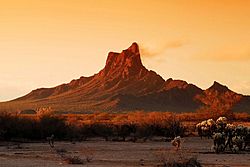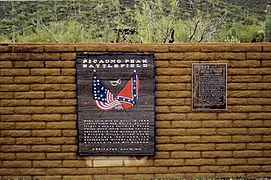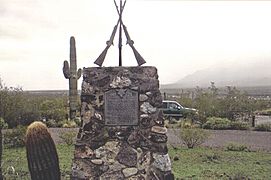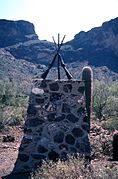Battle of Picacho Pass facts for kids
Quick facts for kids Battle of Picacho Pass |
|||||||
|---|---|---|---|---|---|---|---|
| Part of the Trans-Mississippi Theater of the American Civil War |
|||||||
 Picacho Peak |
|||||||
|
|||||||
| Belligerents | |||||||
| Commanders and leaders | |||||||
| James Barrett † | Henry Holmes (POW) | ||||||
| Strength | |||||||
| 13 cavalry | 10 cavalry | ||||||
| Casualties and losses | |||||||
| 3 killed, 3 wounded | 3 captured, 2 wounded (disputed) | ||||||
The Battle of Picacho Pass, also called the Battle of Picacho Peak, was a small fight during the American Civil War. It happened on April 15, 1862, near Picacho Peak in Arizona. This location is about 50 miles (80 km) northwest of Tucson. The battle was between a group of Union soldiers from California and some Confederate guards from Tucson. It was the westernmost battle of the entire American Civil War.
Contents
Why the Battle Happened
In February 1862, about 120 Confederate cavalry soldiers arrived in Tucson from Texas. They announced that Tucson was the capital of the western part of the Confederate Arizona Territory. This territory included what is now southern Arizona and southern New Mexico. Another town, Mesilla, was named the capital for the eastern part.
The Confederates hoped that many people in southern California would join them. This would give the Confederacy a way to reach the Pacific Ocean. However, this never happened.
Union supporters in California wanted to stop the Confederates. About 2,000 Union volunteers from California, known as the California Column, moved east. They were led by Colonel James Henry Carleton. By May 1862, they had pushed the small Confederate force back into Texas.
Many battles in Arizona during the Civil War, including Picacho Pass, happened near old supply stations. These stations were along the Butterfield Overland Stagecoach route. This route was used for mail and travel but stopped when the war began. The fight at Picacho Pass took place about a mile northwest of one of these stations.
The Battle of Picacho Pass
A group of 12 Union cavalry soldiers and one scout were exploring the Picacho Peak area. They were looking for Confederates who were reported to be nearby. This Union group was led by Lieutenant James Barrett of the 1st California Cavalry. The Confederate soldiers in Arizona were led by Sergeant Henry Holmes.
Lieutenant Barrett had orders not to fight the Confederates right away. He was supposed to wait for the main Union army to arrive. However, Lieutenant Barrett decided to act on his own. He surprised the Confederates.
In the middle of the afternoon, Barrett led his men into a thick area of trees and bushes. The Confederates fired first, hitting four Union soldiers. The Confederates then moved deeper into the thicket to reload their weapons. Barrett followed them, telling his men to come with him.
Three of the Confederate soldiers surrendered. Barrett captured one of them and got back on his horse. At that moment, a bullet hit him in the neck, killing him. The fighting continued for about 90 minutes among the mesquite trees and dry riverbeds. It was a fierce and confusing fight.
Two more Union soldiers were killed, and three were wounded. The Union soldiers were tired and had lost their leader. They stopped fighting and left the area. The remaining Confederate soldiers, who were part of the Arizona Rangers, rode off to warn Tucson about the approaching Union army. Because Lieutenant Barrett did not follow orders, he lost his life, and the Union army lost its chance to surprise Tucson.
After the Battle
The Union troops went back to the Pima Indian Villages. They quickly built Fort Barrett (named after the fallen officer) at White's Mill. They waited there to gather more supplies before moving forward.
Since the Confederates had no extra soldiers to help them, Captain Sherod Hunter and his men left Tucson as soon as the Union army started moving again. The Union troops entered Tucson without any fighting.
The bodies of the two Union soldiers killed at Picacho, George Johnson and William S. Leonard, were later moved. They are now buried at the National Cemetery in the Presidio of San Francisco in San Francisco, California. However, Lieutenant Barrett's grave is still near the railroad tracks, unmarked and untouched. Union reports said two Confederates were wounded, but Captain Hunter's report only mentioned the three men who were captured.
Before this battle, a Confederate cavalry group had gone as far west as Stanwix Station. They were burning hay stored there when Union soldiers from the California Column attacked them. The Confederates were burning hay at these stations to slow down the Union army's advance from California.
Around the same time as the fight at Picacho Peak, a larger Confederate force tried to move north from Santa Fe, New Mexico. They were stopped in the Battle of Glorieta Pass. By July, the Confederates had gone back to Texas. Even though the fight at Picacho Pass was small, it was the farthest west the Confederates reached during the Civil War.
The next year, the Union created its own territory of Arizona. They divided New Mexico along its current north-south border. They then extended their control southward from the temporary capital of Prescott.
Re-enactments
Every March, Picacho Peak State Park hosts a re-enactment of the Civil War battles that happened in Arizona and New Mexico. This includes the Battle of Picacho Pass. These re-enactments have become very popular. Many more people take part now than were in the actual battles. They include soldiers on foot (infantry), artillery (cannons), and cavalry (soldiers on horseback).
The re-enactment in 2015 also showed the Battle of Valverde and the Battle of Glorieta Pass. Both of these battles took place in New Mexico. The site of the skirmish and the remains of the old Butterfield station are listed on the National Register of Historic Places.
Images for kids
- Masich, Andrew E., The Civil War in Arizona; the Story of the California Volunteers, 1861–65; University of Oklahoma Press (Norman, 2006).






